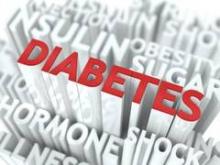The prevalence of diagnosed diabetes in the United States rose significantly from 1988 to 2010, jumping from 6% to 10%.
Prediabetes doubled in prevalence over the same time period, from 6% to 12%, Elizabeth Selvin, Ph.D., and her colleagues reported in the April 14 issue of the Annals of Internal Medicine (2014 [doi=10.7326/M13-2411]).
But while the prevalence of confirmed cases increased sharply, the prevalence of undiagnosed diabetes actually decreased slightly over the same time – meaning that almost all cases of diabetes in the United States are now being identified, wrote Dr. Selvin of Johns Hopkins University, Baltimore, and her coinvestigators. "At present, approximately 89% of all diabetes cases are diagnosed," the team wrote. "Furthermore, glycemic control among persons with diagnosed diabetes has improved, probably reflecting a combination of improvements in diagnosis, screening, and care."
The researchers mined their data from two epochs of the National Health and Nutrition Examination Survey (1988-1994 and 1999-2010), comprising a total of almost 43,500 people. They assessed diabetes and prediabetes prevalence by both fasting plasma glucose and hemoglobin A1c (HbA1c) levels. They also looked at glucose control parameters and medication type in diagnosed patients. To investigate any association between diabetes and weight, they evaluated body mass index in the survey populations.
The mean prevalence of obesity in U.S. adults without diabetes jumped from 21% in the first epoch to 32% in the second. The change was similar among those with diabetes. The increases in both prediabetes and diabetes tracked the jump in obesity, leading the authors to conclude that obesity was a direct cause of disease.
Overall, the mean HbA1c level rose from 5.25% in the earliest years to 5.36% in 2010 – a small but significant increase. But the level was entirely stable in a subset of young adults who had normal body weight, blood pressure, and lipid levels (5%).
The prevalence of diabetes as measured by an HbA1c of at least 6.5% increased over the two epochs, from a low of 6% in the earliest years to 10% by the latest. The prevalence of prediabetes doubled (from 6% to 12%). "When applied to the 2010 U.S. Census, the total number of adults aged 20 [years] or older with total confirmed diabetes was 20.6 million," the authors wrote.
When the team used HbA1c levels to identify undiagnosed cases, they determined that 16% of cases in the earlier epoch were undiagnosed, compared with 11% in the later years – meaning that by 2010, 89% of U.S. cases were being identified.
As measured by an HbA1c of less than 7%, glycemic control improved from 51% to 59% over the study period. Among those who reported that they were taking diabetes medications, control increased from 40% to 55%.
Blacks and Hispanics shouldered a larger disease burden than did whites, the researchers wrote. "The prevalence ... in blacks was nearly double the prevalence in whites (15% vs. almost 9%). Mexican-Americans also had a greater prevalence of diabetes than whites (15.4% vs. 8.6%). Both ethnic minority groups had a greater prevalence of undiagnosed diabetes."
Control was also poorer, they said: Only 52% of blacks and 43% of Mexican-Americans had a calibrated HbA1c level less than 7%, compared with 57% of whites.
"The substantially greater prevalence of diabetes and prediabetes and poor rates of glycemic control (even among persons with medication-treated diabetes) in ethnic minority populations ... is particularly concerning because blacks and Mexican-Americans are also at greater risk for complications of diabetes, particularly retinopathy and kidney disease," the team noted.
The study was supported by the National Institute of Diabetes and Digestive and Kidney Diseases. Neither Dr. Selvin nor any of her coauthors had any financial declarations.
On Twitter @alz_gal


